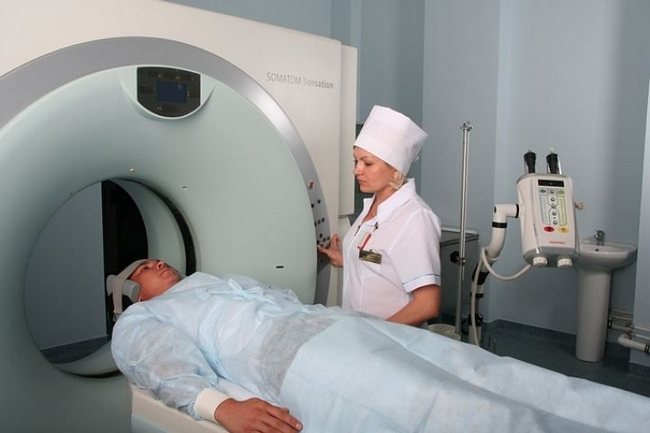Progressive paralysis
Progressive paralysis, or Bayle's disease, is a psychoorganic disease of syphilitic origin, characterized by a progressive disturbance of mental activity with the formation of a persistent defect up to dementia in combination with neurological and somatic disorders. Progressive paralysis is one of the forms of syphilis of the brain, characterized by the occurrence of meningoencephalitis (damage to syphilitic treponema of the brain tissue and its membranes). Only 1-5% of those who have had syphilis develop progressive paralysis. Men suffer 3-5 times more often than women. The average age of patients is from 35 to 50 years, i.e. progressive paralysis develops 10-15 years from the onset of syphilis. In the majority of those admitted to treatment in a psychiatric hospital for progressive paralysis, the syphilitic nature of the disease is established either directly during examination, or by chance during hospitalization in other medical institutions, where a blood test for the Wasserman reaction is mandatory. If a positive result is detected, the patient consults a venereologist, who, in turn, having determined the stage of the disease and predominantly mental disorders, refers him to a psychiatrist.
In other cases, the patient is admitted to a psychiatrist due to abnormal behavior or other mental abnormalities that are noticed by others (the patient usually does not have a critical attitude towards his illness), and the nature of the disease is established in the clinic. Patients, having learned their diagnosis, are often perplexed about this or even deny the presence of syphilis in the past, because they either really did not attach importance to the mild manifestations of the disease at stages 1 and 2 of the disease, or did not complete the full course of treatment for one reason or another.
Symptoms and course:
At the initial stage of the disease, nonspecific complaints of headaches, fatigue, irritability, sleep disturbances, and lethargy appear. However, quite soon signs of personality decline appear with loss of skills, moral attitudes, and intellectual level.
They cannot concentrate, become forgetful, and are unable to perform their usual functions (for example, work). Not only is consciousness of the disease lost, but also unjustified optimism, elevated mood, rudeness, explosiveness, and disinhibition of drives appear. In other patients, on the contrary, dullness, indifference, and lethargy increase.
The middle stage of the disease (paralytic dementia) is characterized by the leveling of individual personality traits with a complete loss of criticism. Either a benevolent high spirits or dull indifference prevails. Memory deteriorates sharply, dementia increases.
The initial stage (marasmus) occurs on average 3-5 years from the onset of the disease. By this time, a complete breakdown of mental activity occurs, physical helplessness develops, leading to death. However, with modern treatment methods, patients usually do not reach this stage, but remain at the level of paralytic dementia.
Recognition:
In addition to mental disorders, progressive paralysis is characterized by neurological manifestations: constriction of the pupils, their unevenness (anisocoria) and irregular shape, lack of reaction of the pupils to light. One of the early symptoms is speech impairment (slurred speech), then epileptic seizures appear, handwriting changes, and tendon reflexes are impaired. When making a diagnosis, special reactions of the blood and cerebrospinal fluid to syphilis are also used. The most famous of them is the Wasserman reaction (R.V.).
Treatment:
It consists of specific antibiotic therapy (8 courses) in combination with bioquinol. In the past, the method of inoculation with three-day malaria was widely used to increase body temperature, which contributed to the death of Treponema pallidum (the causative agent of syphilis). Currently, sulfozine and pyrogenal are used for this. The results of treatment are different and depend on the stage of the disease (the earlier the patient applies, the better the prognosis), as well as on the adequacy of therapy.
Prevention:
Prevention of syphilis in general and carrying out a full course of treatment in the early stages of the disease.
Symptoms of pathology
Symptoms of progressive paralysis will manifest themselves as follows:
- speech impairment and failure in the ability to connect complex words;
- a patient diagnosed with progressive paralysis loses the ability to do basic math, and his motivation decreases significantly;
- the patient's consciousness is clouded;
- memory is lost - both short-term and long-term;
- muscle atrophy and weakness are observed in the upper and lower extremities, as well as weakness in other parts of the body;
- attacks of delirium and hallucinations, increased attacks of irritability and irascibility, which are followed by attacks of depression and moodiness;
- muscle cramp.
Symptoms
The nature of the signs and symptoms can vary greatly from person to person.
Loss of balance when walking is the most common initial symptom of progressive supranuclear palsy. When walking, patients may experience unexplained falls and awkward gait. In addition, muscle stiffness and spasticity occurs. Sometimes falls resemble attacks of dizziness, which lead to an incorrect diagnosis of inner ear diseases.
Other early symptoms include loss of interest in hobbies or pastimes, increased irritability and forgetfulness. Patients may suddenly laugh or cry, be indifferent, or sometimes become angry for no apparent reason.
In addition, speech usually becomes slurred. Swallowing solids or liquids may be difficult. In rare cases, some patients experience tremors and trembling hands.
As the disease progresses, most people develop blurred vision and problems controlling eye movements.
In fact, eye problems, particularly slow eye movements, are usually the first definitive sign that PSP is an appropriate diagnosis. People with progressive supranuclear palsy have trouble moving their gaze in the vertical plane (i.e. down and/or up) and may also have trouble controlling their eyelids. This may result in the need to move your head to look in different directions. The condition may cause involuntary closing of the eyes, prolonged or infrequent blinking, or difficulty opening the eyes. Another common problem is the inability to maintain eye contact while speaking. This may give the false impression that the person is hostile or uninterested.
People suffering from PSP often experience changes in mood and behavior, which include depression and apathy. Some patients experience changes in cognitive processes: judgment, understanding and solving problems and problems, and they may have difficulty remembering words. They may lose interest in activities that they previously enjoyed or become more irritable and forgetful. People may suddenly laugh or cry for no apparent reason, they may be indifferent, or they may occasionally have violent outbursts, also for no apparent reason. Speech usually becomes slow and slurred.
Other symptoms include slow movements, monotonous speech, and a mask-like facial expression. As mentioned, because many of the symptoms of PSP are also seen in people with Parkinson's disease, especially when the disease develops early, progressive supranuclear palsy is often misdiagnosed as Parkinson's disease.
How is progressive supranuclear palsy different from Parkinson's disease?
Both PSP and Parkinson's disease cause muscle spasticity, motor dysfunction, and clumsiness, but PSP progresses more rapidly than Parkinson's disease.
People with progressive supranuclear palsy tend to stand extremely straight or sometimes even tilt their head back (and tend to fall backward). This is called "axial stiffness". Patients suffering from Parkinson's disease, unlike the former, tend to bend forward. Speech and swallowing problems are much more common and severe in PSP than in Parkinson's disease and tend to appear earlier in the course of the disease.
In PSP, eye movements are impaired, but in Parkinson's disease they are close to normal.
Both diseases have other common features: they begin in late middle age, bradykinesia (slow movements) occurs, and both pathologies are characterized by muscle stiffness.
Tremor, which is extremely common in people with Parkinson's disease, is rare in progressive supranuclear palsy. Although people with Parkinson's disease benefit markedly from the drug levodopa, those with PSP respond minimally and experience only short-term improvement while taking the drug. Additionally, patients with progressive supranuclear palsy show a buildup of the protein tau in the affected brain cells, while people with Parkinson's disease show a buildup of another protein called alpha-synuclein.
Prevalence
The disease is based on the progressive degeneration of neurons, resulting from the accumulation of pathological protein in them.
According to modern medical statistics, progressive supranuclear palsy is the cause of 4-7% of cases of diagnosed parkinsonism. But even now, some patients with this disease are misdiagnosed, especially in the early stages. The overall prevalence of progressive supranuclear palsy in the population averages 5 cases per 100 thousand population, from 1.4 to 6.4 cases in different countries.
The disease is detected mainly in people of the older age group; even hereditary forms usually appear at the age of 50 years.
Prevention and prognosis
Since progressive paralysis is a form of syphilis, prevention, first of all, will be aimed specifically at preventing the occurrence of this particular disease.
Thus, preventive measures include:
- avoidance of casual sexual relationships;
- engaging in protected sex only;
- compliance with the rules of personal and intimate hygiene;
- refusal to use household items together with a person with syphilis;
- regular preventive examinations in a medical institution with mandatory visits to all clinicians, including a neurologist.
The prognosis of the disease is generally unfavorable - only every fifth patient achieves complete remission. In 30% of situations, recovery will be accompanied by minor mental manifestations. In other cases, even specific treatment turns out to be ineffective, and the complications described above develop, leading to disability and death.
Diagnostics
This pathology is expressed in a large number of quite specific external manifestations, namely mental disorders. In order to make a correct diagnosis, it is necessary to carry out a wide range of diagnostic measures. First of all, the clinician must personally perform several manipulations, including:
- studying the medical history to confirm the fact of infection with syphilis;
- collection and analysis of life history;
- assessment of the condition of the pupils and visual acuity;
- neurological examination;
- a detailed survey of the patient or his relatives to establish the first time of onset and severity of characteristic symptoms.
Laboratory studies in this case are presented:
- general clinical blood test;
- microscopic examination of cerebrospinal fluid;
- blood biochemistry;
- specific tests with blood serum;
- blood tests for syphilis RIF and RIT.
As for instrumental diagnostics, it is limited to:
- CT and MRI of the head;
- lumbar puncture - this is necessary to obtain cerebrospinal fluid;
- procedures aimed at studying nerve conduction.

CT head photo.
This disease must be differentiated from:
- tumor lesions or vascular pathologies of the brain;
- Pick's disease;
- serous meningitis;
- cerebral atherosclerosis;
- vasculitis and brucellosis;
- sarcoidosis and borreliosis;
- malignant forms of hypertension.
Classification
Progressive paralysis in its clinical picture has several stages of progression, each of which has its own specific symptoms. The stages of progression are:
- initial stage or neurasthenia;
- advanced stage or severe dementia;
- terminal stage or marasmus.
There are also several forms of the disease:
- expansive – the occurrence of manic symptoms, euphoria and meaningless ideas. The person considers himself completely healthy, moreover, he is satisfied with the fact that he is in a psychiatric institution;
- depressive – depressed mood combined with ridiculous hypochondriacal delirium;
- Dementia – an increase in dementia, the patients’ mood is cheerful and complacent;
- tabetic - the addition of signs of tabes dorsalis to the symptoms of paralytic dementia;
- agitated – malignant course. A person's confusion is clearly expressed and mental disintegration quickly develops.
This pathology also includes the following stages:
- latent - begins to develop a year after infection. However, there are no specific clinical manifestations. Headaches and dizziness may occur;
- acute – manifests itself on average after 2 years and has nonspecific symptoms, including nausea and vomiting, a slight decrease in hearing and visual acuity;
- meningovascular - diagnosed in the 7th year of its course. Complaints arise from personality disorders and emotional instability;
- meningomyelitis – there is a disruption in the functioning of the pelvic organs and lower extremities, problems with sensitivity appear;
- tabes dorsalis - often manifests itself after 20 years of the disease. The presence of neurogenic disorders is noted;
- paralytic dementia - begins to develop 10-20 years after infection with syphilis. It is characterized by rapid progression, which often leads to death.
Infantile and juvenile progressive paralysis is also distinguished - it is extremely rare in persons from 6 to 16 years old. In the vast majority of situations, it acts as a rare form of congenital syphilis.








